12 Best Zercher Squat Alternatives For Developing Strength
Zercher Squats are a unique squat variation that can do a great job at developing leg, back and core strength. Instead of loading the bar on your shoulders, you hold the bar on your forearms – just at the crease of your elbow.
As beneficial as Zercher Squats may be, there may be situations where you need a substitution for them.
Maybe you don’t have access to a barbell. Or, maybe you’re looking for a Zercher Squat alternative because they’re crazy uncomfortable on your forearms and you just don’t like doing them.
Whatever the reason, you’re in the right place. I’m about to give you 12 different Zercher Squat alternatives that you can choose from to develop lower body strength.
Zercher Squat Alternatives
I’ve tried to include as much variety in this list of alternatives as possible. There are exercises that incorporate different pieces of equipment – barbells, dumbbells and even one that doesn’t require any equipment at all. There are also beginner-friendly exercises and others better suited for more advanced lifters.
Finally, there are traditional exercises as well as a couple that are a little more ‘outside the box’.
Hopefully, at least one of these exercises will be a good fit for what you’re looking for.
Back Squat
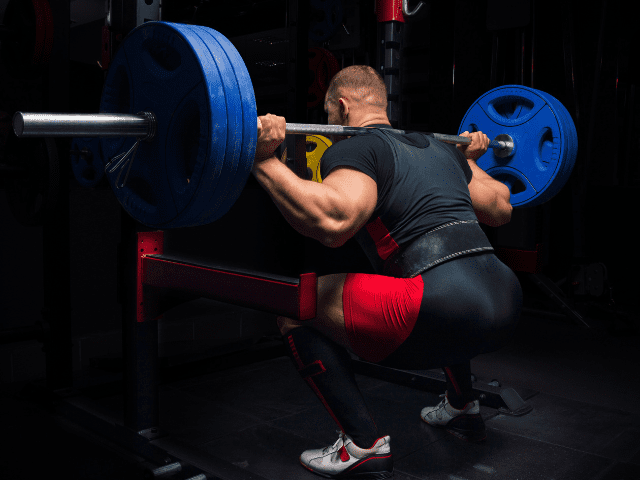
I realize this is probably the most obvious one, but Back Squat is also the best Zercher Squat alternative so it’s going here first. Back Squat is the single-best exercise for building lower body strength, so if you’re able to do them, they should be a staple in your strength training.
How To
- Bar Setup: Place the barbell on a squat rack at chest height. Stand facing the bar.
- Grip and Position: Grip the bar wider than shoulder-width apart and duck under it, placing it on your upper traps.
- Unrack: Stand up, lifting the bar off the rack. Take one or two steps back to clear the rack.
- Starting Position: Stand with feet shoulder-width apart, toes slightly pointing outward. Keep your chest up and eyes forward.
- Initiate Squat: Bend your knees and hips simultaneously, pushing your hips back and down.
- Descending Phase: Lower your body until your thighs are at least parallel to the ground, keeping your knees over your toes.
- Ascent: Push through your heels, extending your hips and knees to return to the starting position.
- Rack: Carefully walk the barbell back into the squat rack and lower it onto the rack.
Coaching Points
It is better to set the safeties one level too low vs one level too high, as the athlete can either let the bar off of their back or allow themselves to lean forward until the bar hits the safeties. In the event the safeties are too high, the barbell has a chance of colliding with them during the exercise.
Front Squat

Even though I think Back Squat is overall a better option, Front Squat is actually more closely related to Zercher Squats. This is because Front Squat is also a front-loaded squat variation, just with a different rack position.
Step-by-Step Instruction
- Bar Setup: Set the barbell on a squat rack at chest height. Approach the bar, facing it.
- Grip and Position: Use a clean grip or cross-arm grip to hold the bar. Place the bar on your front deltoids, close to your neck.
- Unrack: Stand up to lift the bar off the rack. Take a step or two back to clear the rack.
- Starting Position: Stand with your feet shoulder-width apart, toes slightly out. Keep your elbows high and chest up.
- Initiate Squat: Begin by bending your knees and hips, lowering your body towards the ground.
- Descending Phase: Continue lowering until your thighs are at least parallel to the floor, keeping your elbows high.
- Ascent: Push through your heels to extend your knees and hips, returning to the starting position.
- Rack: Carefully walk the bar back to the squat rack and lower it onto the supports.
Coaching Points
Be patient with your flexibility. Persistence and working hard on your flexibility will pay off with Front Squats. Remember to always warm up prior to any lifting session. Work on flexibility drills during warm-up sets as well. After your session, use cool-down techniques, foam roll, stretch, and hydrate.
Hack Squat
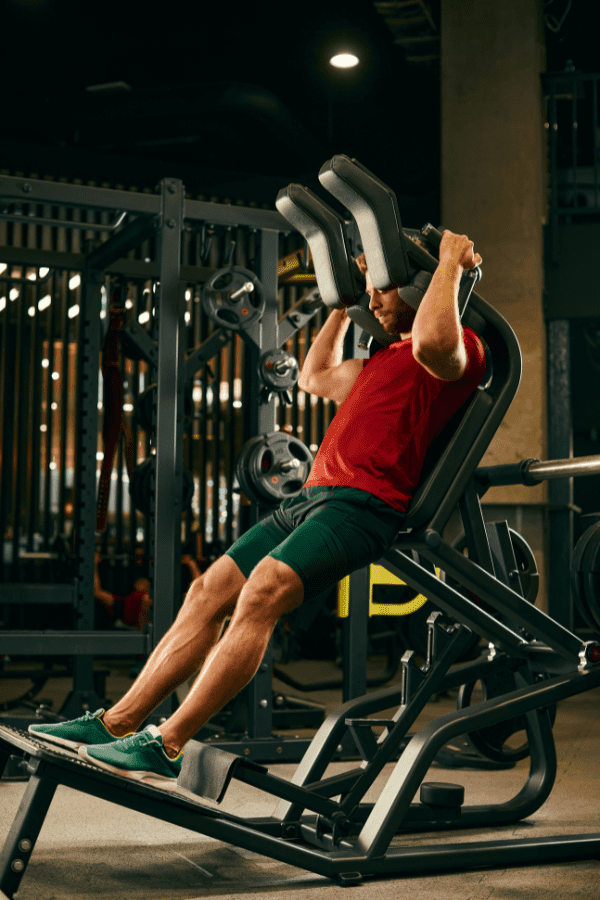
A Hack Squat is a bit of a hybrid between a Back Squat and a Leg Press. It is a machine like a Belt Squat, but Hack Squats are done standing with the weight loaded on the shoulders.
They’re still not as good as a free-weight squat in my opinion, but if you’re able to do them they can add some variety to your training as a Zercher Squat alternative.
Step-by-Step Instructions
- Position yourself on the hack squat machine*, with your back against the pad and your shoulders under the shoulder pads.
- Place your feet shoulder-width apart on the platform, with your toes pointing slightly outward.
- Grasp the handles on either side of the machine (if available).
- Breathe in and brace your core.
- Slowly lower your body by bending at the knees and hips, keeping your head up and your back straight.
- Continue lowering your body until your thighs are parallel to the platform that your feet are standing on.
- Then drive through your feet to raise your body back up to the starting position.
Coaching Points
*Not all Hack Squat machines are the same. Technique, muscles worked and more can and will vary depending on the specific machine you’re using. If in doubt, make sure to speak with someone about how to use the machine in your gym.
You should always start light (especially as a beginner) with any exercise and gradually work toward using heavier weights. This is even more important if you’re working with a machine that you’re unfamiliar with. Always get a feel for the machine first before adding any weight.
Trap Bar Deadlift
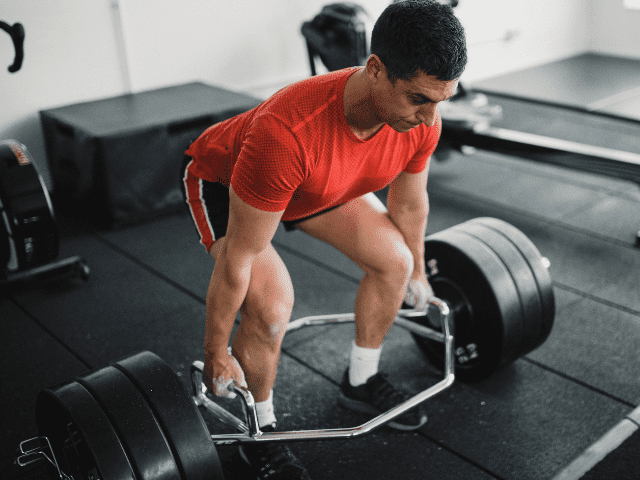
Trap Bar Deadlift isn’t a squat, but it is a Zercher Squat alternative that can still develop a ton of lower body strength. Any deadlift variation is going to target the back as well as the legs, similar to a Zercher Squat.
Using a trap bar (instead of a barbell) makes this variation a little more beginner-friendly.
Step-by-Step Instructions
- Bar Setup: Load the trap bar with the desired weight and stand inside it.
- Starting Position: Stand with feet hip-width apart, aligned with the bar’s handles.
- Grip: Bend at the hips and knees to grab the handles, palms facing your body.
- Brace Core: Take a deep breath and brace your core, keeping your back flat.
- Initial Lift: Push through your heels while extending your hips and knees to lift the bar.
- Lockout: Fully extend your hips and knees, standing upright with the bar.
- Descending Phase: Reverse the movement, lowering the bar back to the starting position.
- Reset: Release your grip and prepare for the next rep.
Coaching Points
Easily the most common mistake for Trap Bar Deadlifts is allowing the back to round, placing unnecessary stress on the back. Keep the back flat throughout the movement and the core braced.
Do not bounce the bar off the floor between reps. Yes, bouncing the plates off the floor into the next rep may make the lift easier to do, but it’s also a good way to allow your technique to break down. Reset for each rep.
Unlike barbells which have a standard weight, hex bars weight can vary from one bar to the next. Keep this in mind if using set weights off of your training program.
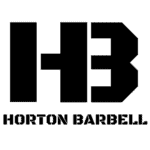
Tired of coming up with your own workouts? But don’t want to pay an arm and a leg?
I post workouts 5 days a week right here. (Did I mention they’re free?)
Single Leg Squat Off Box
Single Leg Squat off a box barely requires any equipment at all. It’s also an incredibly challenging exercise that is much harder than it looks.
Step-by-Step Instructions
- Stand tall with one leg down and the other straight drifting off the side of the box.
- Initiate the squat by hinging at the waist and bending at the knee simultaneously.
- Descend until the hip crease is just below the knee.
- Keep the heel flat and center of mass over the mid-foot.
- Keep the torso as vertical as possible. Sometimes holding the arms straight out from here will help with balance and torso positioning.
- Once you reach depth, drive through the heel, keeping the foot flat, and stand tall.
Coaching Points
Single Leg Squat Off a Box is by far one of the most difficult variations of single-leg training. A proper progression needs to be followed in order to prepare the athlete for a movement like this.
Barbell Step-Up
Barbell Step-Up is another single-leg movement that can make a great Zercher Squat alternative. If the barbell is an issue you can always use dumbbells instead.
Pro Tip: The height of the box plays a huge factor in what muscles are emphasized. A higher box will target the glutes and hamstrings more whereas a shorter box will target the quads more.
Step-by-Step Instructions
- Set up the barbell at the height you would normally use for back squatting.
- Use the high bar back squat position for this exercise.
- Use a box height that is going to allow your hip and knee flexion to be as similar as possible to your stride while sprinting or bounding.
- Unrack the weight, place one foot on the box, and drive the other leg’s knee up.
- The leg drive should be fast and explosive. (Quick note: keep the up leg’s foot pulled up toward the shin).
- Engage the glutes and pause for a brief second at the top of the movement.
- Carefully lower the leg back down and prepare for the next repetition.
Coaching Points
A stable box cannot be overstated here. If the box is not stable, do not do Barbell Step-ups.
Dumbbell Lunge
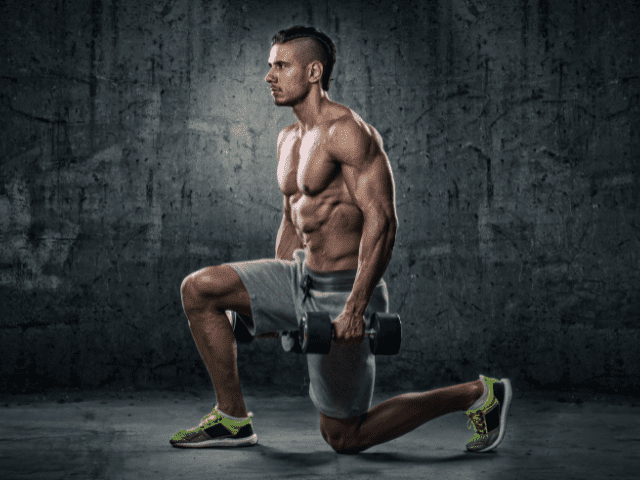
You’re probably already familiar with Dumbbell Lunges as they are one of the most popular lower-body strength exercises. They are popular for a reason, though, Lunges are an extremely effective movement for developing strong legs.
They’re also extremely versatile too – lunges in place, walking lunges and reverse lunges are all simply tweaks you can do to add variety to your workouts.
Instructions
- Grab two dumbbells, one in each hand
- Squeeze the shoulder blades and engage the lats to create a stable back to help with bracing the upper body
- Once you’ve created enough room for yourself from the dumbbell rack (or wherever you pulled them from) you can begin the movement.
- Step forward with one leg, giving yourself enough room to be able to drop into a lunge comfortably without feeling overextended.
- Keep the chest as upright as possible and drop the back knee to roughly one inch from the floor.
- Now drive through the heel and midfoot of the front foot to drive yourself back up tall.
Coaching Points (Fixes to Common Mistakes)
When you step out for Dumbbell Lunges, make sure to keep the feet shoulder-width apart. If you’re feeling very off-balance in your lunge there is a good chance that you are stepping the lead foot directly in front of the back foot (essentially placing yourself on a tight rope).
Bulgarian Split Squat

The final single-leg Belt Squat alternative is the Bulgarian Split Squat. Bulgarian Split Squats are a great movement that takes most of the opposite leg completely out of the movement so all effort is focused on the front leg.
Instructions
- Grab two dumbbells, one in each hand
- Get set up in front of your bench, reach one foot back and place it on the bench. Make sure you feel comfortable and balanced before proceeding.
- Squeeze the shoulder blades and engage the lats to create a stable back to help with bracing the upper body and to keep the dumbbells from swinging unnecessarily.
- Keep the chest as upright as possible and drop the back knee to roughly one inch from the floor.
- Now drive through the heel and midfoot of the front foot to drive yourself back up tall.
Coaching Points (Fixes to Common Mistakes)
When you step your front leg out on a Bulgarian Split Squat, make sure to keep the feet shoulder-width apart. If you’re feeling very off-balance in your set up there is a good chance that you are placing the lead foot directly in front of the back foot (essentially placing yourself on a tight rope).
Keep the front foot flat on the floor when in the lunge position. One of the most common mistakes is raising up onto the ball of the front foot. One of the reasons for this is often the next most common mistake that I see with Dumbbell RFE Lunges…
Make sure to take a big enough step. Often times I see athletes give themselves way too little distance from the bench. This leads to lunge being extremely cramped and can lead to a whole host of other issues (like coming up on the ball of the foot as mentioned above).
Goblet Squat
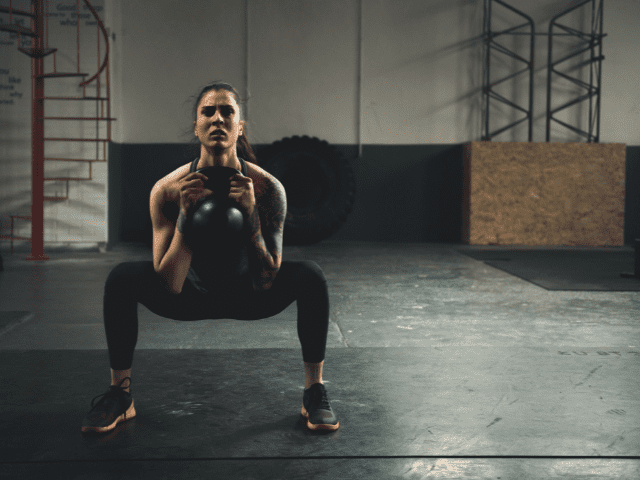
Goblet Squats are essentially a much more beginner-friendly variation of Zercher Squats. The weight is front-loaded but generally lighter than Zercher Squats and the kettlebell is held with the hands instead of having to rest a barbell on the forearms.
Goblet Squats are also a great tool for teaching how to do Back Squats and Front Squats.
Step-by-Step Instructions
- Grab a kettlebell and hold it at chest level, cradling the bottom of the bell in both hands*.
- Stand with feet shoulder-width apart, chest out, lats engaged, eyes straight ahead.
- Before descending into the squat, fill the abdomen full of air and brace the core.
- Start the start by pushing the hips back first.
- Bend the hips and knees, keeping the chest up and knees pushed out until the thighs become parallel to the floor.
- Now push the feet through the floor and drive yourself back up to the starting position.
Coaching Points
*It’s also acceptable to hold the kettlebell on each side of the handle (as shown in the image above).
As with any squat, the most important aspect of Goblet Squats is to keep the core braced to protect the spine and to maintain proper posture – chest out and lats engaged.
Wall Sit
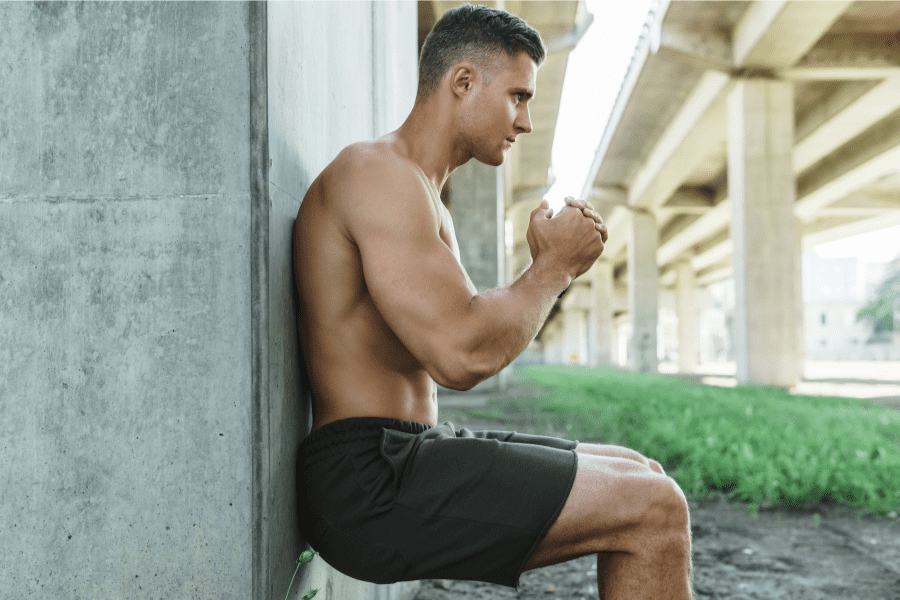
It doesn’t get much simpler than a Wall Sit. But, if you’ve ever done them before you know full well how quickly Wall Sits can light your legs on fire. Wall Sits are great at the end of a workout as a finisher or part of a competition.
They’re also an extremely versatile Zercher Squat alternative because they don’t require any equipment (outside a wall) so you can do them anywhere at any time.
Step-by-Step Instructions
- Find a good, sturdy wall that will be able to safely support your body weight
- Lean back against the wall and place your back flat against the wall.
- Walk your feet out and plant your feet firmly into the ground, shoulder width apart, a few feet from the wall.
- Slide down the wall until your thighs are parallel to the floor.
- Shin angle should now be vertical, ankles just below the knees.
- If you need to quickly reset to adjust the distance your feet are from the wall, do that now.
- Once you are in the sitting position, hold that position for the designated amount of time (or as long as possible)
- Keep hands off legs throughout the sit. They can be held in front or placed on the sides.
Coaching Points
The biggest mistakes I see with athletes when doing Wall Sits all come from the setup. The thighs should be parallel to the floor with the ankles directly below the knees.
Having the hips too high or the feet too far in front of the knees will take strain off of the quads. Athletes inherently know this because these are two of the best ways to try to ‘cheat’ if it’s a competition. (If you ain’t cheatin’ you ain’t tryin’, right?)
Tire Flip

Here is a Zercher Squat alternative that is a little more ‘outside-the-box’. Tire Flips can be an amazing exercise (if you can do them safely) to develop lower body strength and power. If you have a giant tire sitting around, put that thing to use!
How To
- Make sure you have plenty of space to be able to safely flip the tire.
- Start with the tire laying on the ground on its side.
- Stand with toes almost against the tire, feet roughly shoulder-width apart.
- Drop the hips and reach under the tire.
- Once you have a good grip under the tire flatten your back and brace your core.
- Drive the feet through the ground and aggressively begin to extend the hips.
- If the tire is heavy, you can slide one knee under the tire to help with leverage once the tire is high enough.
- When the tire gets above stomach height, flip your hands around so you can begin to push the tire.
- Push the tire forcefully forward – extending with both your arms and legs.
- The tire should land on its side.
Coaching Points
The biggest key to Tire Flips is perhaps in finding the right tire.
Every school I’ve ever worked at had big tires that were used for Tire Flips. However, the size and weight of these tires have all been drastically different. They’ve ranged from tires that were barely heavy enough to be worth using to tires that took two and sometimes even three football players to flip.
Just like with Deadlifts and Power Clean, it’s extremely important to drop the hips, use the legs and keep the back flat. Once fatigue starts to set in I generally see athletes resort to using more back than legs. If form reaches this point then it’s time to stop flipping the tire.
Prowler Push
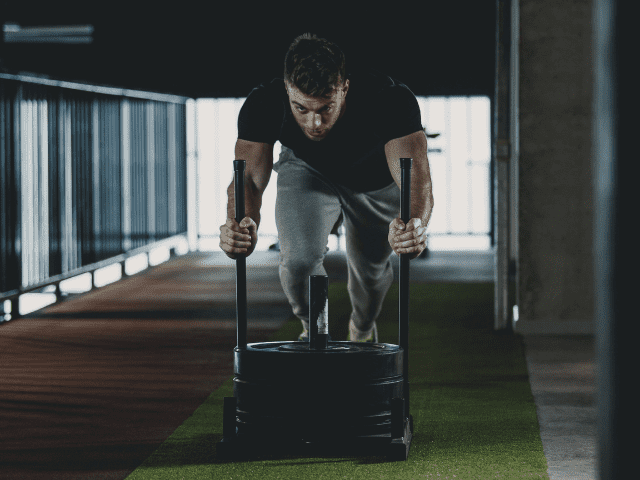
Prowler Pushes are another ‘outside-the-box’ lower body developer that can add some variety to your workouts. They can also build more strength than they are often given credit for – without any loading of the spine.
Pro Tip: Use a lighter weight and quicker tempo to incorporate more of a conditioning component or go slow and heavy to really emphasize strength.
Step-By-Step Instruction
- Set your prowler in an area where you can push it at least 20 yards without hitting anything.
- Load the prowler with weight.
- Get behind the prowler and grab the high handle position.
- Hinge at the waist, bend the knees and extend your arms.
- Drive your legs and push the sled forward.
Coaching Points
The Prowler Push is a full body movement. Keep the core tight, nice neutral spine, and keep those arms extended (Arms can be bent when focusing on heavier loads).
Focus on a strong knee drive and pushing through your feet to keep the prowler moving. Your body angle will be very similar to how you start a sprint. So the lower body action should be very similar to running.
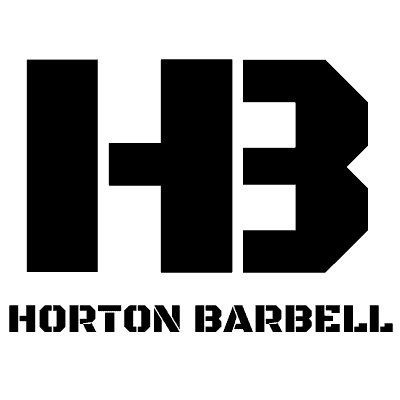
Need a Training Program?
Coach Horton has 20 years of experience training elite level athletes at schools like the University of Tennessee and Georgia Tech. He has also written plenty of programs for other coaches and friends and family.
So, whether you need a program to improve your performance in your sport or you just want to look good at the beach, there is a program designed just for you.
Final Thoughts
The Zercher Squat is a great exercise for developing strength. However, I also understand why people would want to look for a replacement.
As for the list of exercises above, hopefully, at least one of these Zercher Squat alternate exercises can work as a substitute in your strength training program.

